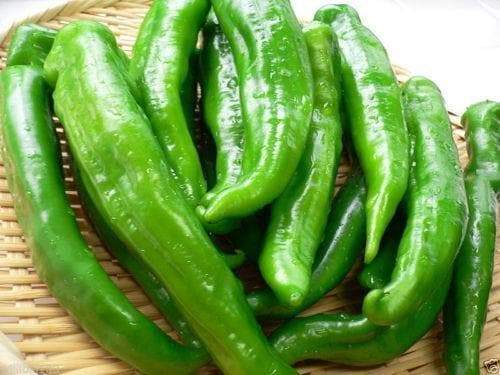
Manganji Pepper Seeds - Japanese Speciality Pepper ,Capsicum annuum, Asian Vegetable
Most orders are processed by the next day
Select your desired size and/or color from the available options.
Manganji
Capsicum annuum
Manganji pepper is one of the designated traditional specialty vegetables of Kyoto, Japan. These vegetables are called kyo yasai or dento yasai. Many of these vegetables have existed for hundreds of years. This Japanese pepper has a thicker wall than the
fushimi and shishito peppers. Fruits average 6" long, mild flavored and not spicy. The pepper skin is shiny with distinctive wrinkles at the stem end.

1
Mix equal parts potting soil, compost, perlite and sphagnum moss. Fill a 12-inch pot 3/4 full with the mixture. The pot should have adequate drainage. Start seeds two months before the planting season. Sow seeds on the surface and cover with a sprinkling of soil. Cover the seeds with plastic and keep them in a south-facing window. Mist the soil to keep it moist.
2
Plant seedlings in time to put them out after the last frost. When planting seedlings, place the plant in the center of the pot and cover the roots with soil. Water thoroughly and add more soil if necessary.
3
Place the potted pepper in full sun. Set a small tomato cage -- 2 to 3 feet high -- over the pot to support the plant as it grows. Water the pepper daily if necessary to keep the soil moist.
4
Fertilize every two weeks with half-strength liquid tomato fertilizer beginning when blooms appear.
5
Harvest the peppers as soon as they ripen to keep the plant producing. Once the pepper turns dark orange or red it is ripe. Cut the pepper from the plant just above the fruit. Peppers left on the plant too long will develop a hotter flavor.
6
Overwinter the plants for the next year. In the fall when the leaves begin to drop, cut the plant back to 3 or 4 inches above the soil line. Place the container in a cool, dark room and leave it until the spring, after frost danger has passed.
LET OUR CUSTOMER SPEAK FOR US

![[Seeds] - Caribbeangardenseed](http://caribbeangardenseed.com/cdn/shop/files/gift-card-gift-card-1_1024x1024_dfa857db-9150-4315-a362-7f0bb3fb9c47_60x28.png?v=1703978838)
